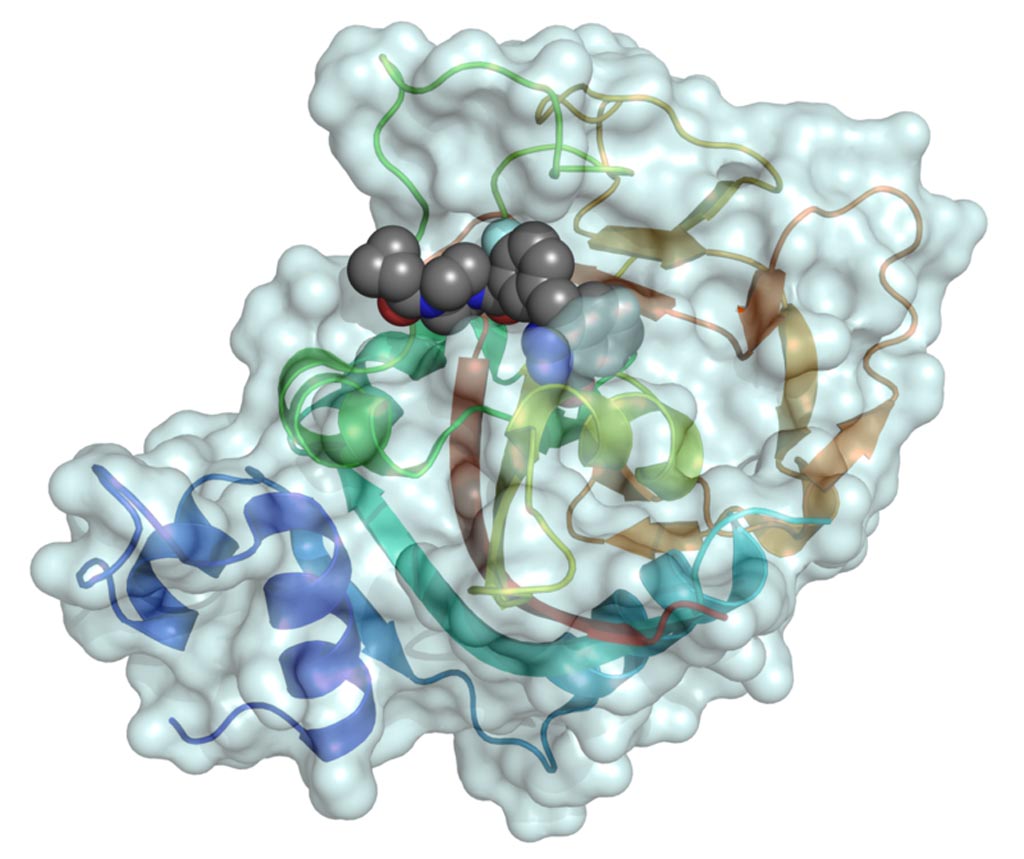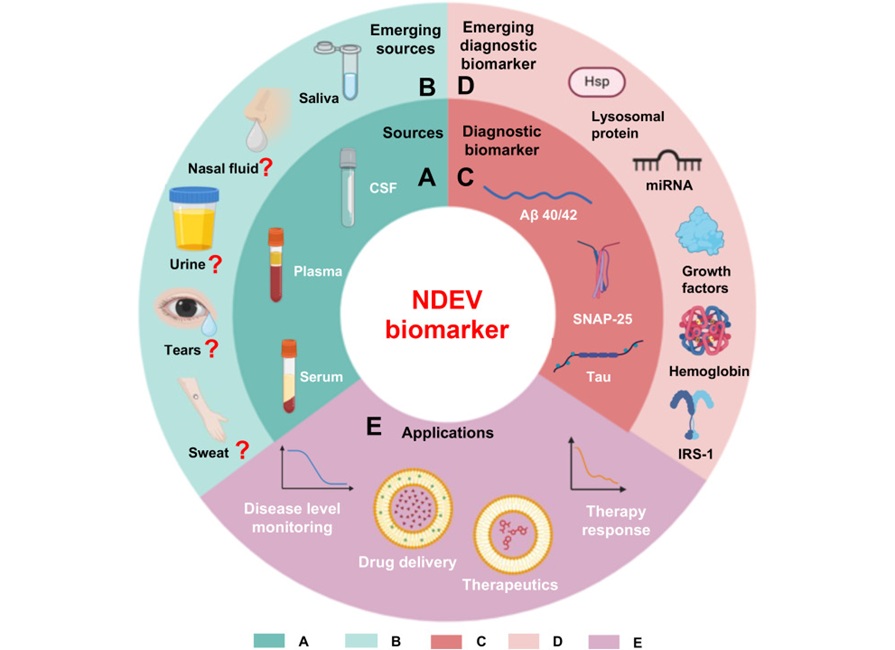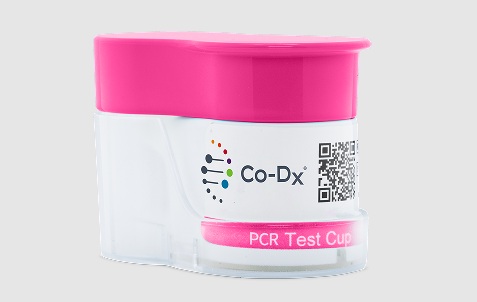Anticancer Duo Kills Tumors While Preventing Relapse
|
By LabMedica International staff writers Posted on 28 Jun 2018 |

Image: A mixed surface–ribbon representation of the catalytic domain of human poly (ADP-ribose) polymerase 1 (PARP1) binding the small-molecule inhibitor olaparib (shown as a space-filling model) (Photo courtesy of Wikimedia Commons).
A suggested new therapeutic approach for killing tumor cells simultaneously blocks both the PARP and RAD52 DNA repair pathways.
Previous studies have shown that BRCA (BReast CAncer susceptibility gene) deficient breast carcinoma cells and leukemia cells could not be completely eradicated by inhibitors of the enzyme Poly (ADP-ribose) polymerase (PARP). The main role of PARP is to detect and initiate an immediate cellular response to metabolic, chemical, or radiation-induced single-strand DNA breaks (SSB) by signaling the enzymatic machinery involved in the SSB repair.
The ability of cancer cells to recover from treatment with PARP inhibitors (PARPis) indicates that more robust and rapid elimination of BRCA-deficient tumor cells is required to prevent time-dependent emergence of PARPi-resistant or refractory clones.
Investigators at Temple University (Philadelphia, PA, USA) hypothesized that RAD52-mediated DNA repair remained active in PARPi-treated BRCA-deficient tumor cells, and that targeting RAD52 should enhance the synthetic lethal effect of PARPi.
In studies described in the June 12, 2018, issue in the journal Cell Reports, cancer cells were treated with the drug olaparib. Initially this drug acts as a PARP inhibitor. BRCA1/2 mutations may be genetically predisposed to development of some forms of cancer, and may be resistant to other forms of cancer treatment. However, these cancers sometimes have a unique vulnerability, as the cancer cells have increased reliance on PARP to repair their DNA and enable them to continue dividing. This means that drugs that selectively inhibit PARP may be of benefit if the cancers are susceptible to this treatment. However, over time cancer cells turn to backup repair mechanisms and adapt to alternative repair pathways, a survival mode that also underlies their ability to evade targeted drug therapies.
The investigators reported that RAD52 inhibitors (RAD52is) attenuated single-strand annealing (SSA) and residual homologous recombination (HR) in BRCA-deficient cells. Simultaneous targeting of PARP1 and RAD52 with inhibitors or dominant-negative mutants caused synergistic accumulation of DSBs and eradication of BRCA-deficient but not BRCA-proficient tumor cells. PARPi+RAD52i exerted synergistic activity against BRCA1-deficient tumors in immunodeficient mice with minimal toxicity to normal cells and tissues.
While the PARP inhibitor olaparib has been approved by the [U.S.] Food and Drug Administration for clinical use, no RAD52 inhibitors have yet been approved.
“Cancers cells have multiple ways of protecting themselves from death,” said senior author Dr. Tomasz Skorski, professor of microbiology and immunology at Temple University. “The tumor cells eventually escape PARP1 inhibition by activating another backup to the BRCA-mediated repair pathway. Our previous work had suggested that RAD52-dependent pathways are a likely escape route, which led us to see whether simultaneous inhibition of both PARP1 and RAD52 could trigger more effective lethality.”
Related Links:
Temple University
Previous studies have shown that BRCA (BReast CAncer susceptibility gene) deficient breast carcinoma cells and leukemia cells could not be completely eradicated by inhibitors of the enzyme Poly (ADP-ribose) polymerase (PARP). The main role of PARP is to detect and initiate an immediate cellular response to metabolic, chemical, or radiation-induced single-strand DNA breaks (SSB) by signaling the enzymatic machinery involved in the SSB repair.
The ability of cancer cells to recover from treatment with PARP inhibitors (PARPis) indicates that more robust and rapid elimination of BRCA-deficient tumor cells is required to prevent time-dependent emergence of PARPi-resistant or refractory clones.
Investigators at Temple University (Philadelphia, PA, USA) hypothesized that RAD52-mediated DNA repair remained active in PARPi-treated BRCA-deficient tumor cells, and that targeting RAD52 should enhance the synthetic lethal effect of PARPi.
In studies described in the June 12, 2018, issue in the journal Cell Reports, cancer cells were treated with the drug olaparib. Initially this drug acts as a PARP inhibitor. BRCA1/2 mutations may be genetically predisposed to development of some forms of cancer, and may be resistant to other forms of cancer treatment. However, these cancers sometimes have a unique vulnerability, as the cancer cells have increased reliance on PARP to repair their DNA and enable them to continue dividing. This means that drugs that selectively inhibit PARP may be of benefit if the cancers are susceptible to this treatment. However, over time cancer cells turn to backup repair mechanisms and adapt to alternative repair pathways, a survival mode that also underlies their ability to evade targeted drug therapies.
The investigators reported that RAD52 inhibitors (RAD52is) attenuated single-strand annealing (SSA) and residual homologous recombination (HR) in BRCA-deficient cells. Simultaneous targeting of PARP1 and RAD52 with inhibitors or dominant-negative mutants caused synergistic accumulation of DSBs and eradication of BRCA-deficient but not BRCA-proficient tumor cells. PARPi+RAD52i exerted synergistic activity against BRCA1-deficient tumors in immunodeficient mice with minimal toxicity to normal cells and tissues.
While the PARP inhibitor olaparib has been approved by the [U.S.] Food and Drug Administration for clinical use, no RAD52 inhibitors have yet been approved.
“Cancers cells have multiple ways of protecting themselves from death,” said senior author Dr. Tomasz Skorski, professor of microbiology and immunology at Temple University. “The tumor cells eventually escape PARP1 inhibition by activating another backup to the BRCA-mediated repair pathway. Our previous work had suggested that RAD52-dependent pathways are a likely escape route, which led us to see whether simultaneous inhibition of both PARP1 and RAD52 could trigger more effective lethality.”
Related Links:
Temple University
Latest BioResearch News
- Genome Analysis Predicts Likelihood of Neurodisability in Oxygen-Deprived Newborns
- Gene Panel Predicts Disease Progession for Patients with B-cell Lymphoma
- New Method Simplifies Preparation of Tumor Genomic DNA Libraries
- New Tool Developed for Diagnosis of Chronic HBV Infection
- Panel of Genetic Loci Accurately Predicts Risk of Developing Gout
- Disrupted TGFB Signaling Linked to Increased Cancer-Related Bacteria
- Gene Fusion Protein Proposed as Prostate Cancer Biomarker
- NIV Test to Diagnose and Monitor Vascular Complications in Diabetes
- Semen Exosome MicroRNA Proves Biomarker for Prostate Cancer
- Genetic Loci Link Plasma Lipid Levels to CVD Risk
- Newly Identified Gene Network Aids in Early Diagnosis of Autism Spectrum Disorder
- Link Confirmed between Living in Poverty and Developing Diseases
- Genomic Study Identifies Kidney Disease Loci in Type I Diabetes Patients
- Liquid Biopsy More Effective for Analyzing Tumor Drug Resistance Mutations
- New Liquid Biopsy Assay Reveals Host-Pathogen Interactions
- Method Developed for Enriching Trophoblast Population in Samples
Channels
Clinical Chemistry
view channel
Compact Raman Imaging System Detects Subtle Tumor Signals
Accurate cancer diagnosis often depends on labor-intensive tissue staining and expert pathological review, which can delay results and limit access to rapid screening. These conventional methods also make... Read more
Noninvasive Blood-Glucose Monitoring to Replace Finger Pricks for Diabetics
People with diabetes often need to measure their blood glucose multiple times a day, most commonly through finger-prick blood tests or implanted sensors. These methods can be painful, inconvenient, and... Read moreMolecular Diagnostics
view channel
Neuron-Derived Extracellular Vesicles Could Improve Alzheimer’s Diagnosis
Alzheimer’s disease is becoming increasingly common as global populations age, yet effective treatments for advanced stages remain limited. Early detection is therefore critical, but current diagnostic... Read more
Sample Prep Instrument to Empower Decentralized PCR Testing for Tuberculosis
Tuberculosis remains the deadliest infectious disease worldwide despite being both treatable and curable when diagnosed early. A major barrier to timely diagnosis is that PCR-based TB testing is still... Read more
Endometriosis Blood Test Could Replace Invasive Laparoscopic Diagnosis
Endometriosis affects an estimated 1 in 10 women globally, yet diagnosis can take 7 to 10 years on average due to the invasive nature of laparoscopy and lack of accurate, non-invasive tests.... Read more
World's First NGS-Based Diagnostic Platform Fully Automates Sample-To-Result Process Within Single Device
Rapid point-of-need diagnostics are of critical need, especially in the areas of infectious disease and cancer testing and monitoring. Now, a direct-from-specimen platform that performs genomic analysis... Read moreHematology
view channel
MRD Tests Could Predict Survival in Leukemia Patients
Acute myeloid leukemia is an aggressive blood cancer that disrupts normal blood cell production and often relapses even after intensive treatment. Clinicians currently lack early, reliable markers to predict... Read more
Platelet Activity Blood Test in Middle Age Could Identify Early Alzheimer’s Risk
Early detection of Alzheimer’s disease remains one of the biggest unmet needs in neurology, particularly because the biological changes underlying the disorder begin decades before memory symptoms appear.... Read more
Microvesicles Measurement Could Detect Vascular Injury in Sickle Cell Disease Patients
Assessing disease severity in sickle cell disease (SCD) remains challenging, especially when trying to predict hemolysis, vascular injury, and risk of complications such as vaso-occlusive crises.... Read more
ADLM’s New Coagulation Testing Guidance to Improve Care for Patients on Blood Thinners
Direct oral anticoagulants (DOACs) are one of the most common types of blood thinners. Patients take them to prevent a host of complications that could arise from blood clotting, including stroke, deep... Read moreImmunology
view channel
Ultrasensitive Liquid Biopsy Demonstrates Efficacy in Predicting Immunotherapy Response
Immunotherapy has transformed cancer treatment, but only a small proportion of patients experience lasting benefit, with response rates often remaining between 10% and 20%. Clinicians currently lack reliable... Read more
Blood Test Could Identify Colon Cancer Patients to Benefit from NSAIDs
Colon cancer remains a major cause of cancer-related illness, with many patients facing relapse even after surgery and chemotherapy. Up to 40% of people with stage III disease experience recurrence, highlighting... Read moreMicrobiology
view channel
New UTI Diagnosis Method Delivers Antibiotic Resistance Results 24 Hours Earlier
Urinary tract infections affect around 152 million people every year, making them one of the most common bacterial infections worldwide. In routine medical practice, diagnosis often relies on rapid urine... Read more
Breakthroughs in Microbial Analysis to Enhance Disease Prediction
Microorganisms shape human health, ecosystems, and the planet’s climate, yet identifying them and understanding how they are related remains a major scientific challenge. Even with modern DNA sequencing,... Read morePathology
view channel
AI Tool Simultaneously Identifies Genetic Mutations and Disease Type
Interpreting genetic test results remains a major challenge in modern medicine, particularly for rare and complex diseases. While existing tools can indicate whether a genetic mutation is harmful, they... Read more
Rapid Low-Cost Tests Can Prevent Child Deaths from Contaminated Medicinal Syrups
Medicinal syrups contaminated with toxic chemicals have caused the deaths of hundreds of children worldwide, exposing a critical gap in how these products are tested before reaching patients.... Read more
Tumor Signals in Saliva and Blood Enable Non-Invasive Monitoring of Head and Neck Cancer
Head and neck cancers are among the most aggressive malignancies worldwide, with nearly 900,000 new cases diagnosed each year. Monitoring these cancers for recurrence or relapse typically relies on tissue... Read moreTechnology
view channel
AI Predicts Colorectal Cancer Survival Using Clinical and Molecular Features
Colorectal cancer is one of the most common and deadly cancers worldwide, and accurately predicting patient survival remains a major clinical challenge. Traditional prognostic tools often rely on either... Read more
Diagnostic Chip Monitors Chemotherapy Effectiveness for Brain Cancer
Glioblastoma is one of the most aggressive and fatal brain cancers, with most patients surviving less than two years after diagnosis. Treatment is particularly challenging because the tumor infiltrates... Read moreIndustry
view channel
BD and Penn Institute Collaborate to Advance Immunotherapy through Flow Cytometry
BD (Becton, Dickinson and Company, Franklin Lakes, NJ, USA) has entered into a strategic collaboration with the Institute for Immunology and Immune Health (I3H, Philadelphia, PA, USA) at the University... Read more










 (3) (1).png)









